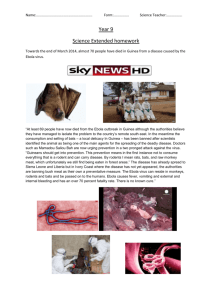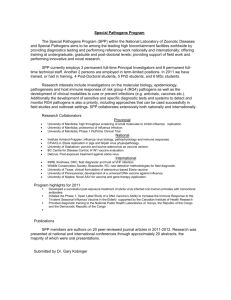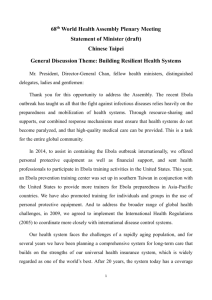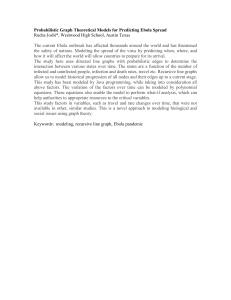file
advertisement
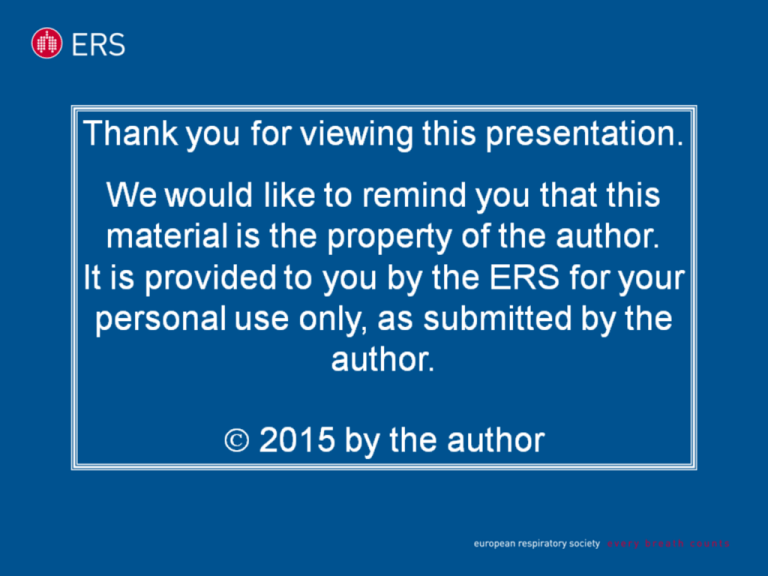
Ebola: Progress with Vaccines Pandemics and Emerging Infections Sarah Gilbert, Jenner Institute, University of Oxford THE JENNER INSTITUTE THE JENNER INSTITUTE a partnership between Oxford University and the Pirbright Institute - Developing innovative vaccines - Partnering with industry - Driving the One Health agenda Human Vaccines Pipeline Disease Area Number of GMP Vaccines Preclinical Phase I Phase IIa Oxford Malaria 17 TB 3 HCV 3 HIV 5 Pandemic Flu 2 Meningitis 1 RSV 3 Ebola 4 Prostate cancer 2 Phase Ib Phase IIb Phase III Patient Group /Endemic Area Staph aureus The busiest pipeline of any non-profit vaccine institute Licensure Ebola in West Africa, 2014 • Epidemic in Guinea, Liberia, Sierra Leone – international public health emergency declared in August 2014 – 28, 295 cases, 11, 295 deaths by September 2015 – No vaccines, no drugs licensed • Two vaccines had shown single dose efficacy in macaques – Chimpanzee adenovirus vector – Vesicular stomatitis virus vector Adenovirus-Based Vaccine against Ebola This Ebola Vaccine, ChAd3 EBO Z, induces strong immune responses in non-human primates B cell response Experimental design 1010 or 1011 vp ChAd3 (N=4) Weeks 0 1000 pfu ZEBOV 4 Ad5 average 5 Plasma IgG ELISA PBMC ICS ChAd3 induced anti-GP IgG titers above the level that predicts 100% protection for an Ad5 vaccine T cell response Ad5 average Ad5 average ChAd3 induces high levels of anti-Ebola GP CD4 and CD8 T cells Stanley et al. Nat Med 2014 A Single Injection of 1010 vp ChAd3 EBO Z Fully Protects Macaques from Ebolavirus Ebolavirus Ebolavirus challenge challenge Vaccinate ChAd Ebola GP n = 4 /group 0 1 2 3 4 5 One year Acute protection 100 % Protection Weeks: Ebolavirus challenge 80 60 40 20 0 Ad5 1010 vp ChAd3 1010 vp Stanley et al. Nat Med 2014 ChAd3-ZEBOV prime/MVA-ZEBOV boost induces 100% protection from EBOV at one year 0 1 2 3 4 5 One year Acute protection Durable protection 100 % Protection Weeks: Ebolavirus challenge Ebolavirus Ebolavirus challenge challenge Vaccinate ChAd Ebola GP n = 4 /group 80 60 40 20 0 Ad5 ChAd3 ChAd3/MVA Accelerated Ebola Vaccine Development • Chimpanzee adenovirus 3 vaccine chosen • WHO / Oxford / Wellcome / GSK / Okairos / NIH plan – Phase I in Oxford mid-September: 60 volunteers – Phase I in Mali: 80 volunteers – Parallel manufacturing of 20,000 doses of ChAd3 EBO Z • Objectives – Safety data in 140 volunteers, especially healthcare workers – Immunogenicity comparable to protected macaques • Decision on whether to deploy in phase III: December 2014 – Primary target population: healthcare workers Oxford Ebola Vaccine Trial • First vaccination 17 September 2014 • Three doses assessed in 60 vaccinees by 18 November – Approval to immunise in West Africa given by Data Safety Monitoring Board by 4 October 2014 Ebola Vaccine Trial Timeline 14 August 26 August 30 August 2 September 5 September 8 September 9 September 11 September 15 September 16 September 17 September 18 November Grant application submitted Award letter Vaccine filled Trial file submission to UK regulator Ethics meeting Ethical approval Regulatory approval Vaccine shipping Vaccine labelled Trial contract signed 1st vaccinee 60th vaccinee First Volunteer in Bamako, Mali CONFIDENTIAL Oxford Trial Results: Safety • The ChAd3 vaccine has been safe in 92 Oxford vaccinees – and in many others • 91 in Mali, 100 in Switzerland, 20 in USA • Some arm soreness, rarely fevers, but well tolerated – Similar to other ChAd vectors and most other vaccines EBOZ Antibody Immunogenicity ADI ELISA = response rate Mean antibody level: 235 402 469 3700 was the correlate of protection in macaques Rampling et al. NEJM January 2015 Viral Vector Vaccines to Maximise Immunogenicity 8 weeks Adenovirus Prime MVA Boost Malaria, HCV, HIV, influenza, TB, RSV, Ebola Two MVA Products • MVA-BN Filo – Used in the first Oxford trial – Glycoproteins of Zaire and Sudan strain of Ebolavirus • Also nucleoprotein of Taï Forest strain of Ebolavirus and Marburg virus glycoprotein • MVA-EBOZ – NIH doses manufactured by mid-2014 (n = 800) – Large scale manufacture undertaken with Wellcome funding • > 30,000 doses; filled in February • Made on a cell line, not chick embryo fibroblasts MVA EBO Boost Design • 30 of the total of 60 ChAd3 EBO Z vaccinees boosted with MVA – at 3 – 10 weeks (mean of 6 weeks) – 10 subjects from each ChAd3 dose level – Dose either 1.5 x108 or 3 x 108 pfu • MVA was well tolerated – in Oxford and subsequently in Mali Ebola Antibody Responses Increased by 20-fold using an MVA Booster Vaccine > No Correlation between ChAd-MVA Dose Interval and Antibody Titre Exceptional CD8+ T Cell Potency with 1 Week Prime-Boost Interval Further Vectored Ebola trial in Oxford PI: Matthew Snape • Prime boost study using – Ad26 ZEBOV – MVA-BN – Johnson & Johnson-sponsored • Ad26 - MVA and MVA - Ad26 – Four or eight week interval – Excellent immunogenicity with both regimens • 72 volunteers in total, started December 2014 ChAd3-MVA Progress July 15 2015 Update • 46 MVA-BN boosted subjects in Oxford • 27 MVA-BN boosted subjects in Mali • 21 vaccinated in Oxford MVA-EBOZ trial • 35 vaccinated in Dakar MVA-EBOZ trial Remarkable immunogenicity in UK and Africa - with a satisfactory safety profile Vesicular Stomatitis Virus Vector another vaccine approach for Ebola • • • • • A rhabdovirus vector Single dose efficacy in short term challenges in macaques Replication competent! Previously used only in two lab workers New Link Genetics & Public Health Agency of Canada - WHO - Merck VSV Ebola Vaccine Progress: Safety • Trials from 5 sites reported in April 2015 – 170 subjects in total • • • • • 51 in Geneva, Switzerland 40 in Maryland, USA 39 in Lambarane, Gabon 20 in Kilifi, Kenya 20 in Hamburg, Germany • Viraemia in 94% of subjects • Fever in 35% • Arthritis in 11/51 vaccinees in Geneva – Fewer at other sites • Three doses compared Agnandji et al., Regules et al. NEJM April 2015 Field Trials in West Africa 1. 27,000 subjects in Liberia – ChAd3 and VSV single dose regimes 2. 8,000 healthcare workers in Sierra Leone – VSV 3. 9,000 ring vaccinated subjects in Guinea – i) VSV and ii) ChAd3 +/- MVA 4. >40,000 subjects in Sierra Leone – Ad26 - MVA Declining Case Incidence Initial Efficacy Data April to July, 2015, Guinea, Ebola ça Suffit trial 90 clusters, total population of 7651 people included in the planned interim analysis. 48 of these clusters were randomly assigned to immediate vaccination with rVSVZEBOV, and 42 clusters randomly assigned to delayed vaccination with rVSV-ZEBOV. Immediate vaccination group no cases of Ebola virus disease with symptom onset at least 10 days after randomisation, Delayed vaccination group 16 cases of Ebola virus disease from seven clusters Vaccine efficacy of 100% (95% CI 74·7-100·0; p=0·0036). 43 serious adverse events were reported; one serious adverse event was judged to be causally related to vaccination (a febrile episode in a vaccinated participant, which resolved without sequelae). Assessment of serious adverse events is ongoing Henao-Restrepo et al., Lancet, 2015 Comparing Immunogenicity Ewer et al. manuscript submitted Assays performed by Thomas Strecker Stefan Becker Institut für Virologie University of Marburg Some Outbreak Pathogens “The Known Knowns” • Ebola virus • Chikungunya virus • Marburg virus • Rift valley fever virus • MERS coronavirus • Crimean-Congo hemorrhagic fever virus • Enterovirus 71 • Hendra virus • Monkeypox virus • SARS coronavirus • Nipah virus • Venezuelan equine encephalitis virus • • West Nile virus • Pandemic influenza Lassa virus No licensed human vaccine for any of these! Will There Be More Major Outbreaks? • Almost certainly! – More people, especially in Africa – Bigger cities – More long distance travel – Many viruses lurking – And new viruses like SARS An Alternative Route for Licensure of Vaccines against Outbreak Pathogens • Demonstrate efficacy in a suitable animal model • Identify immunological correlates of efficacy • Demonstrate in clinical trials that these immune responses can be achieved safely • Develop an adequate safety database – In thousands of subjects – In diverse populations • Have plans in place to test the vaccines if an outbreak occurs A Suggested Way Forward for Outbreak Pathogens • Vaccine development to phase II trials for all of these pathogens – Safety and immunogenicity as for Ebola – Largely public funding – Preferably a common manufacturing platform • Vaccine stockpiles held in affected regions – 10,000 to 50,000 doses – Emergency use approvals and efficacy evaluation – Learn from existing stockpiling strategies 7 June 2015 PM to pledge £20m to tackle future pandemic threat Conclusions • Rapid clinical trial responses to outbreak pathogens are possible – the Ebola response speed has been unprecedented – but there is room for improvement • Many viral threats exist against which we have no human vaccines – a new strategy is required to develop these vaccines, for which the business case is weak Acknowledgements Jenner Pre-Clinical Alison Turner Alex Spencer Tess Lambe Nick Edwards CVD Mali, Bamako Samba Sow Myron Levine Marburg University Thomas Strecker Stephan Becker WHO Marie-Paule Kieny Vasee Moorthy NIAID, NIH Barney Graham Rick Koup Nancy Sullivan University of Dakar Birahim Ndiaye Souleymane Mboup Emergent Biosolutions Eric Balsley Rick Welsh Bavarian Nordic Paul Chaplin Ariane Volkmann UK Clinical Trials Adrian Hill Ruth Payne Felicity Hartnell Navin Venkatraman Danny Wright Georgie Bowyer Rachel Roberts Tommy Rampling Alison Lawrie Babatunde Imoukhuede Katie Ewer Eleanor Berrie GSK Vaccines Ripley Ballou François Roman

